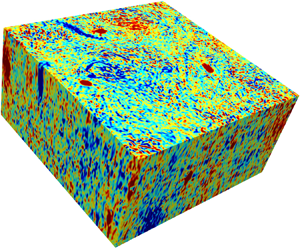Published online by Cambridge University Press: 03 February 2021

A broad spectrum of internal gravity waves coexist with the geostrophic balanced flow in the world's oceans. Satellite altimeter data sets, in situ observations and global scale ocean model outputs collected over the past one decade reveal significant variability in the balance-to-wave energy ratio in the world's oceans. Notably, wave-dominant regions of the world's oceans are characterized by the internal gravity wave spectrum overtaking the geostrophic balanced flow's spectrum at mesoscales. Inspired by these recent data sets, in this paper we explore turbulent interactions between a broad spectrum of internal gravity waves and the geostrophic balanced flow in different balance-to-wave energy regimes. Our results based on numerical integration of the non-hydrostatic Boussinesq equations reveal that the balanced flow remains unaffected by waves as long as wave energy is not significantly higher than balanced energy. Even in parameter regimes where wave and balanced energies are comparable, balanced flow undergoes an inverse energy flux with energy accumulating in large domain-scale coherent vortices. In contrast, we find that wave-dominant regimes are composed of two-way wave–balance energy exchanges and a forward flux of geostrophic energy. The geostrophic balanced flow in such regimes is composed of fine-scale structures that get dissipated at small scales and show no sign of coherent vortex formation. Our findings reveal that sufficiently high energy waves can reverse the direction of the geostrophic energy flux – from inverse to forward – enhancing geostrophic energy dissipation. Given that the balance-to-wave energy ratio is highly variable in the global ocean, the forward flux and associated small-scale dissipation of balanced energy could play an important role in high wave energy regions of the world's oceans. The prominent mechanisms suggested for dissipating balanced energy in the world's oceans require balanced flow to encounter different forms of boundaries. In contrast, the wave-induced dissipation of balanced energy described in this paper is an attractive mechanism that could dissipate balanced energy in the interior parts of the oceans and away from all forms of boundaries.